Home internet is evolving fast, powered by dramatically faster internet connections, the limiting factor is often no longer the cable coming into your hour, but rather the router you use to connect your devices to the internet.
If you’re on the NBN, many Australian homes are connected to fibre-to-the-premesis (FTTP), or at least fibre-to-the-curb, alternatively, you may have a connection coming from something like Starlink delivering hundreds of Mbps.
As our source internet speeds increase, getting that speed to your devices is an exercise in removing barriers in between. One potential barrier is your home router.
If you’re still rocking the default router that came from your ISP, you could be the perfect candidate for an upgrade to a router like this.
WiFi 7, also known as 802.11 be, is all the rage in home networking routers. Netgear’s RS700 WiFi 7 Router is a recent entrant into the market and offers lots of features, chiefly among them are a 10Gbps Internet port to optimize the latest internet services.
Earlier this year, I upgraded to a 1Gbps home internet service with Superloop and there’s already talk of new 2Gbps consumer plans on the way. This router is ready for the future, with an internet port that’s capable of 10 Gbps.
Getting fast internet into your router is one thing, but it’s the 10 Gbps LAN port that’ll allow you to get it out to devices.

Design
The Netgear RS700 features a sleek, modern design that looks at home if it lands on your kitchen bench, but for many, it’ll live in the garage, connected to the NBN Network Termination Device.
The angular form factor and matte black finish give it a professional yet understated appearance. The router is relatively compact, making it easy to position in various locations around the house without being an eyesore.
This is a large departure from the spider designs of the past that featured massive external antennas, numerous antennas are now inside the router’s housing, strategically placed to ensure optimal signal distribution.
The LED indicators on the front provide clear, intuitive feedback about the network status and connectivity, while the rear houses an array of ports for wired connections, ensuring versatility in setup.
Overall the design is quite simple, but I did appreciate the yellow marking on the flagship port, responsible for delivering as much as 10Gbps of internet. With earlier implementations, to get this speed, you needed to purchase a separate 10Gbps SFP module at an additional cost. Thankfully this is now included and setup is simple.
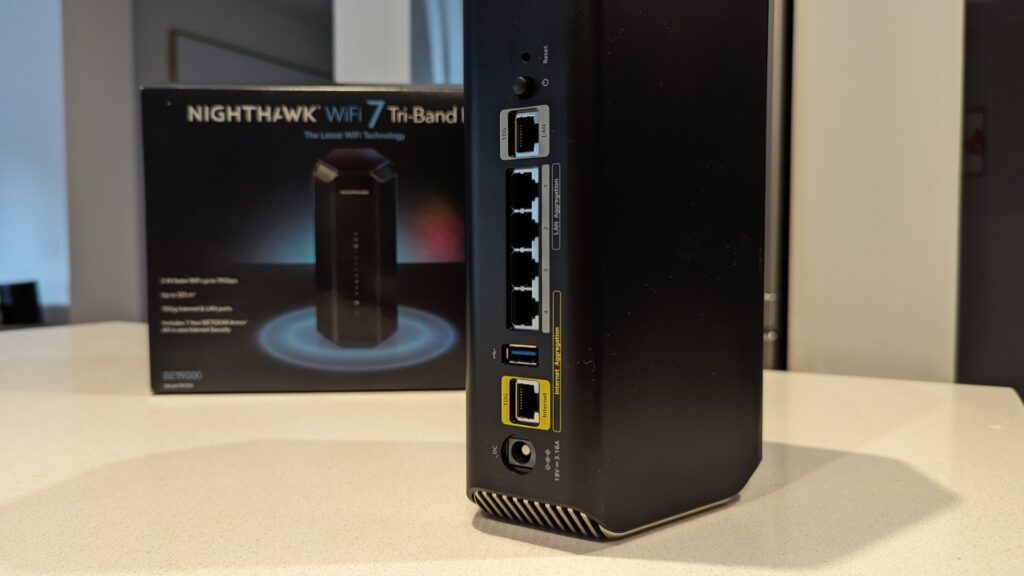

Features
WiFi 7 Technology
The standout feature of the RS700 is its support for WiFi 7, the latest wireless standard that brings significant improvements in speed, capacity, and efficiency. WiFi 7, also known as 802.11be, utilizes the 6 GHz band in addition to the traditional 2.4 GHz and 5 GHz bands.
This tri-band configuration allows for higher data throughput and reduced latency, making it ideal for bandwidth-intensive applications like 8K streaming and virtual reality gaming.
Multi-Gig Connectivity
The RS700 is equipped with a 10G WAN/LAN port, which supports multi-gig internet plans and future-proofs your network as higher-speed internet services become more widely available.
This port allows for a direct connection to your internet service provider, ensuring maximum possible speeds are achieved. Additionally, the router includes four 2.5G Ethernet ports, providing ultra-fast wired connections for gaming consoles, PCs, and other high-demand devices.
Advanced Security
Security is a top priority for the RS700. It supports WPA3 encryption, the latest and most secure WiFi security protocol, which offers stronger protection against cyber threats.
Netgear Armor, powered by Bitdefender, adds an extra layer of security by providing real-time protection against malware, viruses, and data theft.
This subscription-based service is a valuable addition for users looking to safeguard their home network comprehensively.
Enhanced Network Management
Netgear’s Nighthawk app provides a user-friendly interface for setting up and managing the RS700. The app allows users to monitor their network, manage connected devices, and optimize performance with ease.
Advanced features such as Quality of Service (QoS) prioritize bandwidth for critical applications, ensuring smooth performance for gaming and streaming. The app also supports remote management, giving users the flexibility to control their network from anywhere.
Beamforming and MU-MIMO
To enhance wireless performance, the RS700 includes beamforming technology, which focuses the WiFi signal directly towards connected devices rather than broadcasting it in all directions.
This targeted approach improves signal strength and reliability, especially for devices located further from the router.
MU-MIMO (Multi-User, Multiple Input, Multiple Output) technology allows the router to communicate with multiple devices simultaneously, reducing wait times and improving overall network efficiency.
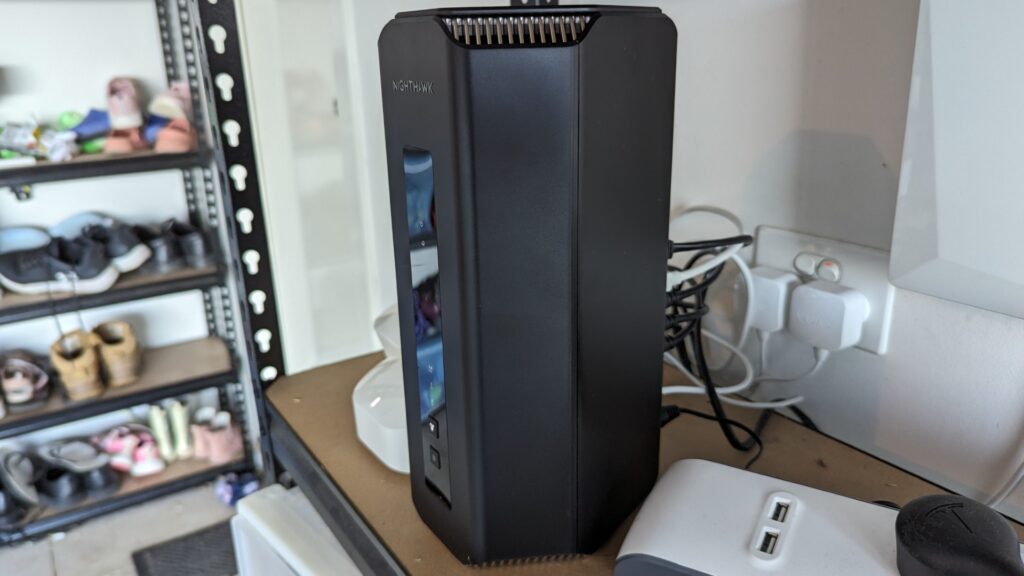

Performance
In terms of performance, the reality of the internet at home in 2020 is the best you’re likely to have is a 1Gbps connection via the NBN coming into the NTD on fibre.
The next chain in the internet puzzle is how you get the internet from the NTD to the router and from the router to home devices (like PCs). Right now, you’ll very likely have Cat 5e ethernet cables, capable of delivering 1Gbps.
If you want to see this 10 Gbps, or anything close to it, you’ll need to upgrade your Ethernet cables to 6a category, which offers up to 10 Gbps in speed, but again there are no consumer plans available today anywhere close to this.
As recently as May 16th, NBN announced they were bringing forward multi-gigabit speeds, with the target of bringing hyperfast speeds (2,000/200 Mbps) wholesale plans to retailers. This would require Next Generation FTTP Network Termination Devices (NTDs). The consultation will run through Q1 of FY2025, so don’t expect it tomorrow, but it is on the way.
The story is a little different for Enterprise Ethernet customers who have the capacity for higher tiers (as much as 10Gpbs) and the budget and workloads to support it. This router would be perfect for some of those applications, however you’re likely to also have enterprise-grade networking infrastructure to support that.
Whether you have internet speeds of 1Gbps today and 10Gbps in the future, the router’s ability to handle multiple high-bandwidth tasks simultaneously without a hitch is particularly noteworthy.
With real-world speeds over 920Mbps, I threw some A-typical use cases at it, because anything typical can easily be accommodated by these crazy speeds.
Performance testing included:
- 4x 4K YouTube streams at 2160p.
- Download Games Updates via Stream on PC
- Streaming Video Podcast (Spotfiy) on mobile phone
- Xbox One X download game updates
With all of this content happening simultaneously, it really does make me think what workloads you would need to have to actually use this level of bandwidth.. and thinking towards the future, what on earth could you need 10Gbps for?
The answer is almost certainly videos, if we fast forward a few years, perhaps 8K content becomes prolific and the price of 8K displays comes down to an affordable price. Even with 8K, at 120fps and HDR, it’s still likely, with modern compression algorithms, we’re still looking at ~100 Mbps of bandwidth per stream.
If you’re a business with 100 users hanging off the connection, then sure, but a house of 3-4 people is unlikely to stretch the legs of this router.
In terms of performance, I will highlight that as amazing as this router is, with all of its WiFi 7 goodness, I came from using a mesh wireless system (Amazon Eero). It’s not really fair to compare a single router with multiple mesh units, except for the fact that the price per internet will always be compatible.
I placed the Netgear RS700 WiFi 7 Router in the garage, next to the NBN NTD, so my test was a difficult one, to reach the other end of the house, through many walls (laundry, bedroom, bedroom, bathroom, bedroom). The speed achieved was still very healthy at over 90Mbps. Naturally, this was less than the Eero mesh provided with a 3 units bouncing the signal throughout the house.
My primary device is my PC in the home office, on the opposite side of the garage wall. I regularly achieved more than 940Mbps using existing Ethernet cables.
The final test was to connect the RS700 to the Eero mesh, offering the best of both worlds, taking the best inbound connection and distributing it through our house via the wireless mesh networking.
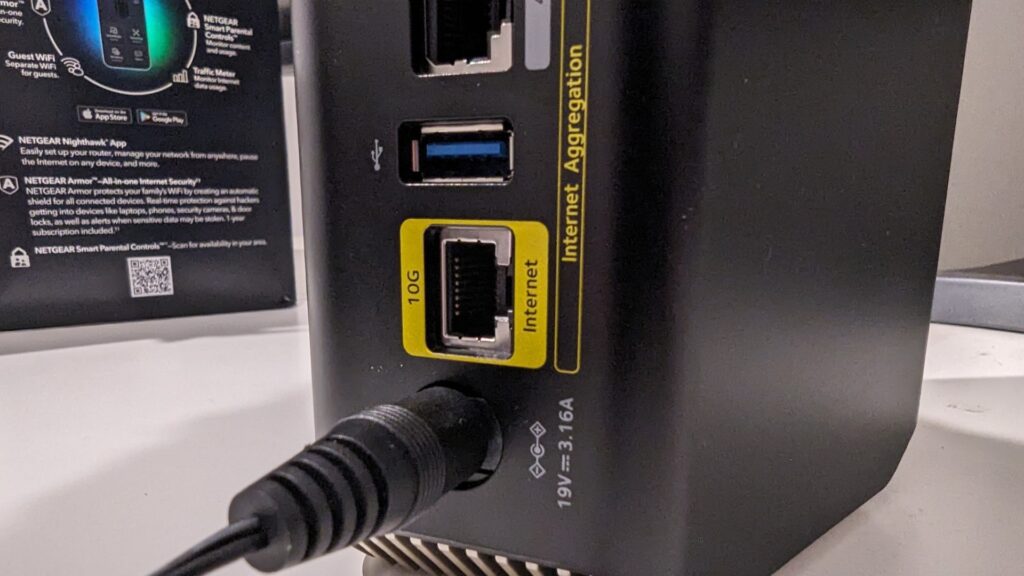

Issues and Opportunities
Despite its stellar performance, the RS700 is not without its issues. The initial setup can be somewhat daunting for those who are not tech-savvy, although Netgear’s Nighthawk app does simplify the process to some extent.
Additionally, its benefits are likely overkill for many users, even those with 100Mbps connections, which typically used to be considered very fast. The price of the router really demands you have some strong use cases to justify the price, which is substantially more than most other routers on the market.
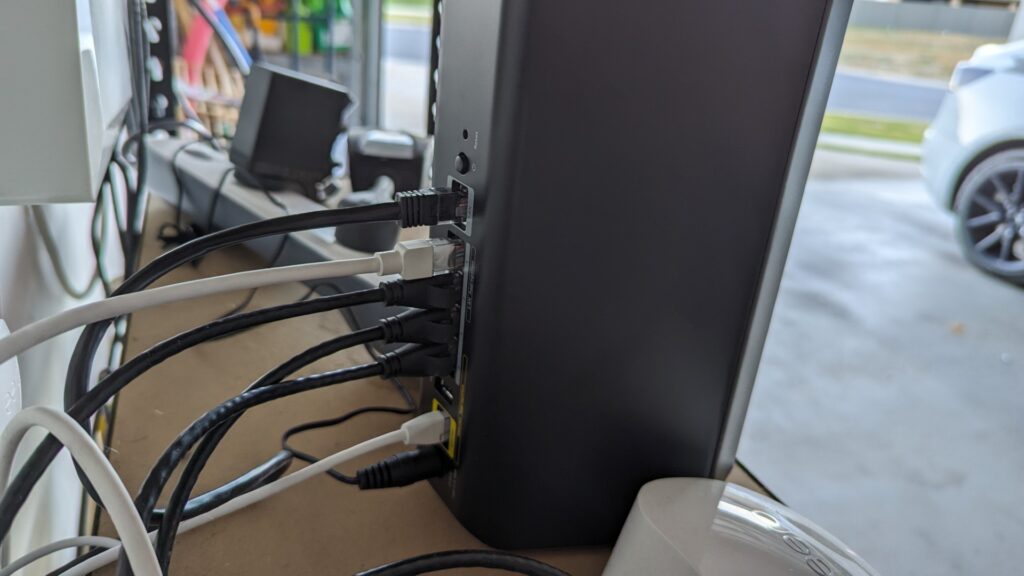

Price and Availability
In the Australian market, the Netgear RS700 WiFi 7 Router is positioned as a premium product, with a price tag to match. As of now, it retails for A$1,499 at JB Hi-Fi, but we have seen the same product on Netgear’s Amazon Store for 21% off for just A$1,189.
The router is available through major electronics retailers. While the price is on the higher end, the RS700 offers something a little special with 10Gbps Internet and LAN ports to absolutely make sure you have a clean run in the future. This may appeal to tech enthusiasts (or a house full of them) and users with demanding network needs like gamers and those early adopters of 8K TVs.
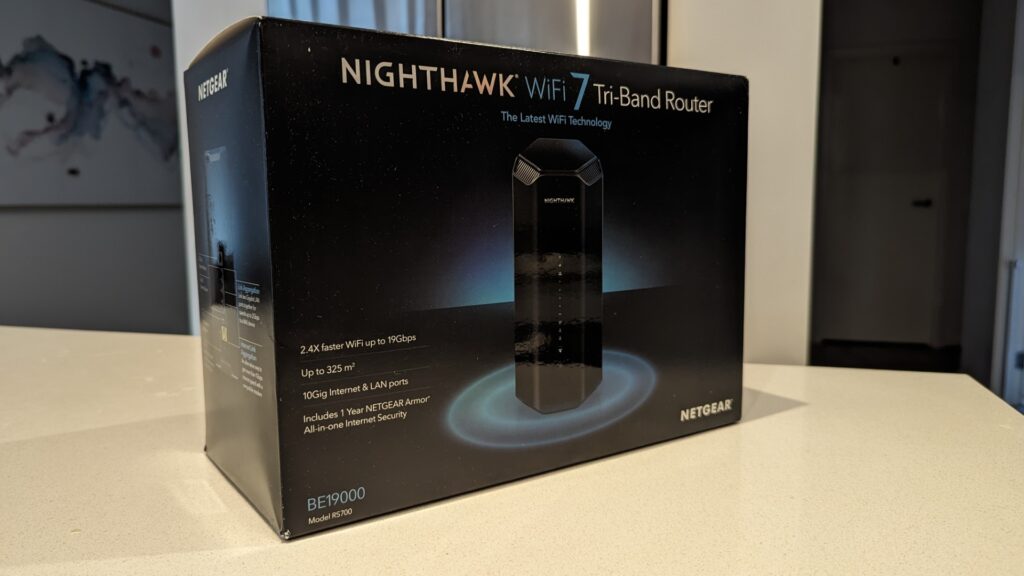

Overall
The Netgear RS700 WiFi 7 Router is an exceptional piece of networking hardware, setting a new standard for home wireless connectivity. Its advanced features and impressive performance make it a standout choice for tech enthusiasts and households with demanding network needs.
As much as I love the latest technology, this is a lot, even for me. There are plenty of amazing routers on the market for half this price, making it really difficult to recommend. The speed here and the ability to cope with future demands are basically second to none, but it needs to be cheaper to make sense.
If you are in the market for a new router and don’t want to buy another for 5-10 years, then the Netgear RS700 is worth considering, but it’s likely to become a favourite among small-to-medium businesses that need to share internet to multiple users who can take advantage of the speed.

Are you sure it has four 2.5gb ports? Looking on their site, it shows the four ports being 1GB ports
Are you sure the four ports are 2.5GB? Looking on their site it indicates the four ports are 1GB..